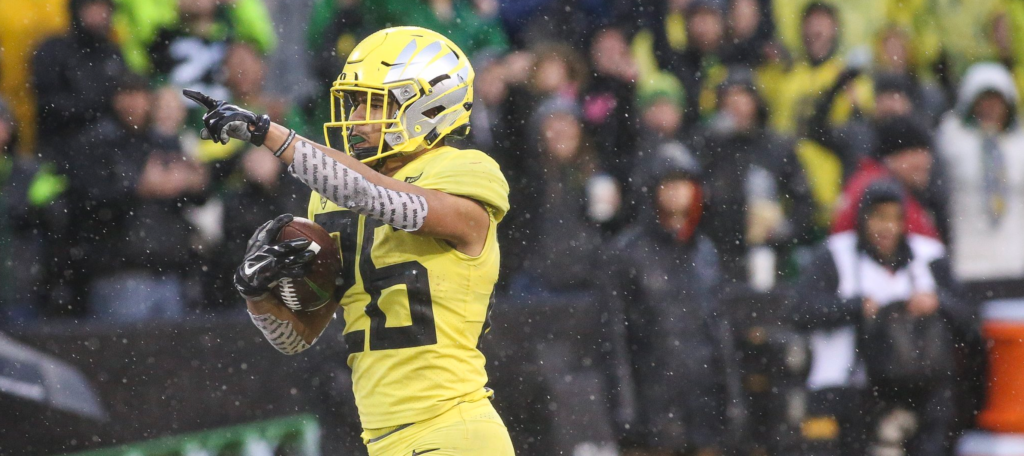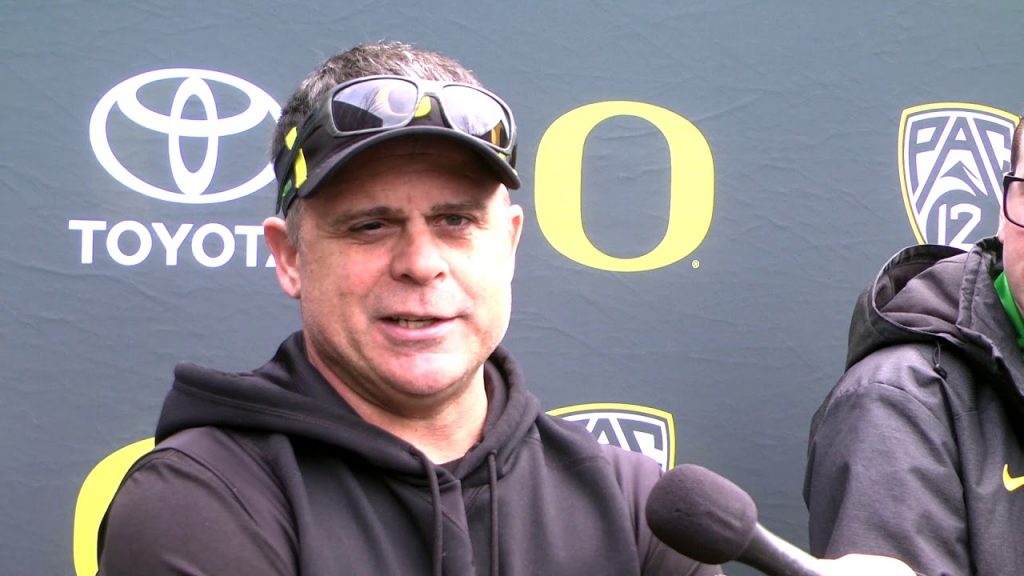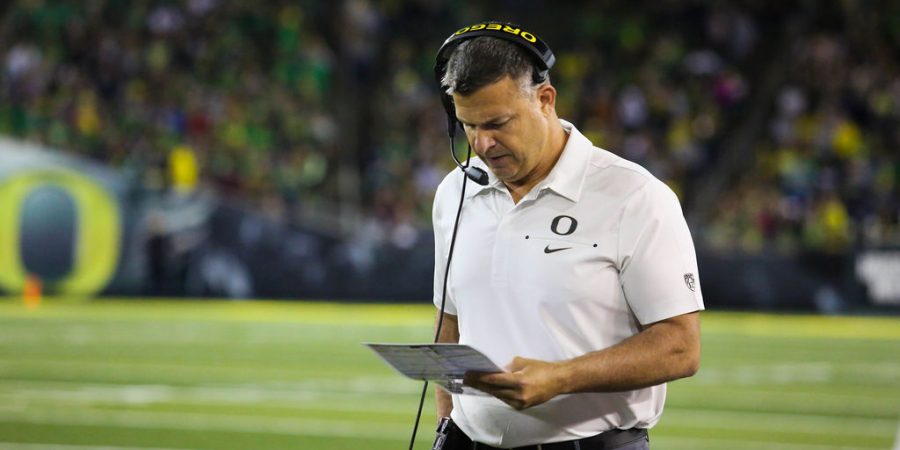For a full decade (plus a year) spanning either parts or the entire tenures of three head coaches (Mike Bellotti, Chip Kelly, Mark Helfrich), the Oregon Ducks ruled the roost when it came who led the Pac-10/12 in rushing offense. In fact, from 2006 to 2016, the Ducks not only led the conference in rushing in each of those years, but they finished in the top 15 or better nationally in nine of those years, which included three top 10 and five top five finishes over that span.
Even in 2017, during Willie Taggart’s first and only season as the Oregon head man, the Ducks finished second in the Pac-12 in rushing offense (251 yards/game), which marked the 11th time in the 12 years prior that Oregon had finished the year averaging over 200 yards rushing per game. Remarkably, last season was the first time since 2006 that Oregon did not eclipse the 200-yard per game rushing mark as a team, as they averaged 179.4 yards per contest.
Of course, the roughly decade-long stretch coincided with the arrival of Kelly, who not only helped elevate the Ducks to all-new statistical heights on offense, but also helped revolutionize the landscape of college football with the ruthless execution of the no-huddle spread offense.
Those were different days, as now virtually every program across the country has implemented no-huddle, up-tempo concepts into their overall approach on offense. With that, it’s only natural to expect some sort of regression to the median if you’re a Duck fan. Still, it is nonetheless odd in recent seasons to see an Oregon team lack the kind of gusto on the ground that we’ve grown accustomed to seeing.

Last season, some of those struggles could be explained away by the inexperience at the running back position, as outside of Tony Brooks-James (a player who was mostly utilized, and at his best, as a change of pace back to Royce Freeman), Oregon largely relied on three players who were receiving their first carries as collegiate running backs in CJ Verdell, Travis Dye, and Cyrus Habibi-Likio. This season, however, has felt like more of the same.
Despite being a year older and a year wiser, and despite having the advantage of running behind the most experienced offensive line in the country, Verdell, Dye, Habibi-Likio, and Darrian Felix – who was sidelined virtually all of last season – have struggled to ignite the Oregon ground attack, ranking sixth in the conference in rushing offense (186 yards/game) through three games. Certainly competition has played a role in these fairly modest numbers, as the opening game of the season against Auburn and their stellar defensive line saw the Ducks limited to just 90 yards rushing (2.7 yards/carry). However, in games the last two weeks against Nevada and Montana, the Ducks have averaged just over six yards per rush attempt (6.1).
Those aren’t bad numbers by any stretch, but neither of those contests showed a consistent ability on Oregon’s part to get chunk yardage against teams who should be “getable” in that regard. In fact, the Ducks needed a four-quarter effort from Travis Dye in order to narrowly earn their first 100-yard rushing performance by an individual this season, as Dye finished with 101 yards on the night.
Attempting to identify the true culprit has made the matter that much more frustrating.

Some have suggested that the elements of the Pistol offense that Oregon has adopted since hiring running backs coach and run game coordinator Jim Mastro has been the reason why production has stymied. After all, the approach hasn’t exactly showcased a ton of variety beyond a heavy dose of power between the tackles and the occasional off tackle or jet sweep that gets sprinkled in. After being held to just 88 yards rushing on 23 attempts (3.8 yards/carry) in the first half vs. Montana last Saturday, the Ducks seemed to make a more concerted effort to attack the perimeter with the run game, which led to dramatically more success on the ground after halftime (159 yards rushing in the second half).
Others have opined that the Ducks simply lack the talent at the running back position, or perhaps more pointedly, lack the right kind of talent at running back that best fits with Cristobal’s desire to install a running game predicated on strength and power. There definitely aren’t any physical marvels like Jonathan Stewart, LeGarrette Blount, or Royce Freeman on the roster. Neither is there anyone like, you know, LaMichael James or Kenjon Barner – two of the greatest rushers in school history – whose obvious talent would have likely meshed well with whatever ideal Mastro and Mario Cristobal have for the ground attack. Those kinds of players give definition to an offensive identity, not to mention produce box office excitement. But beyond Justin Herbert, this offense lacks those kind of obvious identity makers, and perhaps no more glaringly at the moment than at running back.
In truth, the criticism likely lies somewhere in the tug-o-war involving both schools of thought, but no matter where you lean, you recognize that this doesn’t feel super sustainable. The coaching staff likely agrees, but with conference play about to kickoff and an important opportunity at hand, the emergence of the run game may ultimately dictate how high this team can fly.


From what i can see, Oregon hasn’t been that successful throwing the deep ball unless there is broken coverage and the guy is open. If a defense feels that their won’t be blown assignments, then they should cheat the safeties near the box and stop the run. Make Oregon throw deep until they can prove they can. I think that’s why in the Montana game Herbert threw so many horizontal passes – he probably was reading the safeties creeping in the box, so the read is to throw to the perimeter.
Another factor as mentioned in the article, is the talent isn’t there. Oregon previously had RBs that at least sniffed the NFL – Dye and Verdell aren’t at the level. They aren’t particularly elusive, nor are they particularly big/fast/quick. There’s good depth, just not that threat that can break tackles. The games I watch, the RBs typically go down close to first contact.
It was mentioned during the Auburn game that opposing defenses will sell out to stop Oregon’s ground game. With the WR struggles last year, and all the injuries to the group this year, defenses feel they can cover all downfield threats.
As long as Oregon has Justin Herbert, running more would be wasteful of his considerable talent.
For how high our line grades out it definitely narrows the culprits. I’m picking option c, Maestro is not developing the running backs to do anything other than pass blocking and hitting the line at top speed, hole or no hole. patience and vision are not to be strived for. I think Maestro should be let go. But he’s Mario’s hire unlike Johnson was, so he’ll continue to damage the running game through next year at least.
You can’t have five top five finishes and only three top ten. Math doesn’t work
Thanks for the note, Jefe. I’m not a math guy, but I think the math checks out here. Though, I suppose there can be a bit of confusion in terms of defining a top 10 finish vs. a top 5. After all, finishing 3rd in the nation in rushing offense still technically counts as a top 10 finish.
Just for reference, between 2006-2016, the Ducks had nine top 15 finishes or better (in terms of rushing offense, nationally):
Top 15 – 2006 (14th)
Top 10 – 2007 (6th), 2009 (6th), 2013 (9th)
Top 5 – 2008 (2nd), 2010 (4th), 2011 (5th), 2012 (3rd), 2015 (5th)
You want to run the ball successfully use Herbert and our much better receivers to stretch out the Defense im the first quarter. Everybody in the pac-12 knows Oregon starts the game running 70 to 80% of plays. Too predictable. You can’t run through 8 guys at scrimage no matter how good your lineman and backs are.